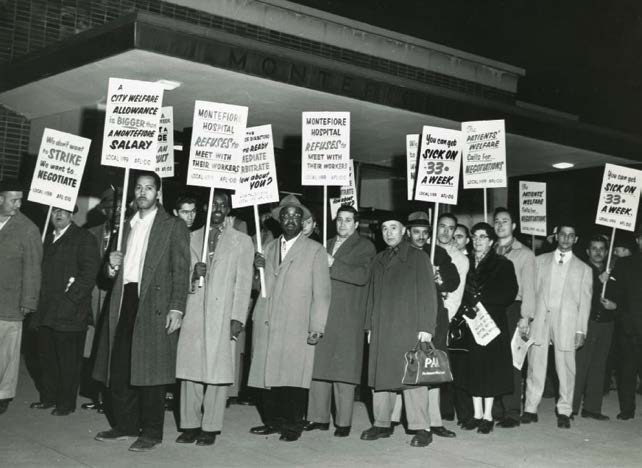Solidarity Was Key Ingredient In Historic 1959 Victory
April 17, 2019
Pharmacy workers went the extra mile.

The hospitals, led by some of the most powerful and wealthy New Yorkers, were Mount Sinai, Beth Israel, Lenox Hill, Flower-Fifth Ave. and Beth David (the latter two have since closed) in Manhattan; Bronx (now BronxCare Health System); and Brooklyn Jewish (now Interfaith). The workers were among the city’s most exploited. Most earned about $32 a week with no benefits and often horrendous working conditions.
The media characterized the campaign as David versus Goliath. Hospitals were exempt from labor laws because they were considered charitable organizations. And the great majority of unions were reluctant to organize poverty-wage workers, most of whom were women of color.
But pundits and management of the hospitals greatly underestimated 1199. They assumed the campaign would sputter because they doubted that the workers could endure a protracted strike.
The Union’s history told a different story. Founded by leftwing activists, 1199’s officers and members, led by President Leon Davis, were committed to wall-towall unionism, as well as racial and ethnic solidarity. Partly resulting from the anti-Semitic quota system in many medical schools, Jewish men dominated the pharmacist trade. And about 20 percent were Irish or Italian.
Also in 1937, the Union launched a campaign to hire Black pharmacists in Harlem and to promote Black workers to the position of porter. 1199 was also one of the first unions to hold annual observances of Negro History Week—now African- American History Month.
The Union leaders also understood the importance social and political activism. The Union not only assembled crack organizers, but also had on its team, Moe Foner, widely acknowledged as labor’s most astute public relations director.
But the key ingredient was the committed members. They demonstrated their support for the organizing campaign by voting to increase their monthly dues by $1 for finance the campaign. “African American workers were downtrodden, and we felt that bringing pharmacy and hospital workers together would help us all,” says Morton Wechsler, an 1199 pharmacist in the 1950s. “We won because we were like family.” Now 93, Wechsler worked at several pharmacies on Long Island most of which have closed. He credits 1199 with elevating the status of pharmacists and says he wishes he had put in more years at 1199-organized drugstores. His son, Robert Wechsler is a pharmacist and delegate at Northwell Plainview Hospital on Long Island.
During the organizing campaign, other pharmacy workers, including stockmen, porters and soda men, demonstrated their commitment by joining the “Crack of Dawn Brigades.”
That was the name given to the hundreds of workers who picked up organizing leaflets in the evening before rising early the next morning to distribute the leaflets to hospital workers. After that, they would head to their pharmacy jobs.
Leon Fink and Brian Greenberg in “Upheaval in the Quiet Zone,” the fine history of 1199, recount an early episode of the Brigades. Phil Kamenkowitz, then the Union director for the Bronx and Washington Heights, wanted to demonstrate to member organizers how to interest workers at Knickerbocker Hospital in Harlem. Before dawn, Kamenkowitz approached an older worker outside the hospital and announced, “I’m from 1199 here to organize you.” Before he could say another word, the worker grabbed his hand and declared, “Thank God the Union’s here.” A frequent refrain of the hospital workers was, “What do we have to lose!”
In a 2009 interview, John Perkins, a former pharmacy clerk and president of the Union’s Retired Members Division (RMD), recalled his days as a youthful Brigade member. “I’m not a professional organizer,” Perkins said. “But I always made sure people heard what we had to say. We made sure that management knew we were human beings and that we were the ones who were doing the work.”
The hospital campaign was led by Organizing Director Elliott Godoff and Teddy Mitchell, a former drugstore clerk and 1199’s first African American VP. Also, the Union hired as organizers Montefiore worker activists. Among them were Puerto Rican and immigrant workers from the Caribbean. Montefiore LPN Thelma Bowles was one of a few women organizers. The number of women pharmacists and drugstore workers at the time was minuscule.
During the campaign, dozens of women emerged from the ranks. The late Lena Hayes, a former RMD president, earned $29 for a 44-hour week as an aide at Manhattan’s Mt. Sinai Hospital. “That struggle changed my life forever,” Hayes said in a 2015 interview. She resisted the pleas of her mother to cross the picket lines or to find another job, noting that the Union, though it didn’t have much in its treasury, provided strikers with food, car fare and other forms of assistance. Julia Davis, the wife of Leon and a former welfare worker, headed up the strikers’ welfare committee. During the strike, the committee helped some 600 workers apply for public assistance.
After 46 days, management agreed in June, 1959 to a compromise settlement. They didn’t recognize the union, but all workers returned to work and a “Permanent Administrative Committee” was set up to review the strikers’ demands.
“It was the unity of the pharmacists and hospital workers that made the difference,” Wechsler says. Lawrence Silber, another pharmacist at the time and a former Pathmark 10-years delegate, agrees. “We pharmacists agreed to add a dollar to our monthly dues because we knew that building a bigger more powerful union would help us all,” he says.
Silber, now 88, points with pride to the many picket lines and negotiating committees on his resume. “Today, retired pharmacists like me have a great pension and health benefits. Politicians and bosses know when they deal with 1199, they are dealing with a powerful union.”
1199 Magazine | March / April 2019

